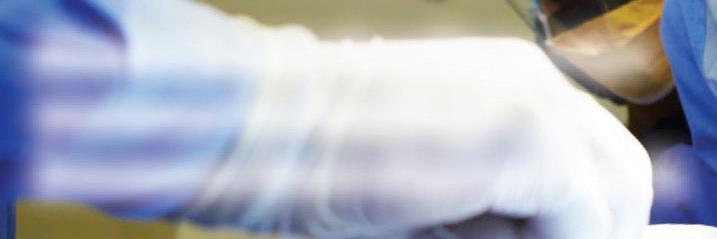
5 minute read
ROBOTICS
The basics you need to know to make medical robots
Photo courtesy of Adobe Stock
Medical robots and robotic devices bring complex challenges to the table. Manufacturers must be prepared to address them to bring a product to market.
Bill Stearns | Intertek | Medical robots are complex, with lots of pieces and components: base stations, robotic arms, sophisticated software, instruments and integrated support equipment. These robotic subsystems are often designed and assembled by multiple teams, including software, hardware, medical professionals, integration and regulatory. These teams can be siloed within a company or spread out geographically. Medical robot makers also frequently subcontract subsystems or parts to other manufacturers.
Medtech manufacturers need to pay greater attention and emphasize coordination to ensure they produce a successful complex device and avoid mistakes. Here are some best practices and ways to prepare for obstacles and overcome them.

Communicate and document
Everyone involved in developing a medical robot must communicate well from the beginning, and those communications must include everyone: designers, engineers, medical experts, programmers, robotics teams, R&D and compliance managers.
Miscommunications and missteps can increase costs and waste time. From the start, manufacturers should establish, share and clarify the goal, expectations, responsibilities, timelines and deadlines to ensure the process is as smooth as possible. All teams should have a common quality system for a compliant design and
a smooth regulatory approval process. Using a common quality system allows each subsystem to integrate properly into the top-level product design fi le. Teams should also apply common risk management, software development and usability processes across all subsystems.
Using different processes makes system integration increasingly complex, leaving companies to evaluate different processes during the regulatory review. This requirement can add unnecessary cost and increase time to market. When subcontracting components or subsystems using a different quality system, the manufacturer must review, accept and integrate the subsystem design fi le into the product design fi le.
Medtech companies should also use common procedures to document and communicate among the different product teams to ensure all teams follow and use the same processes, forms and worksheets.
Robot basic safety, essential performance, hazards and assessments
Like other types of medical equipment, medical robots fall within the scope of IEC 60601-1, which includes requirements for basic safety and essential performance. Some basic safety requirements include preventing shock,


Robotics-Assisted Surgery: Critical Challenges and Critical Challenges and Robotics Opportunities Robotics Opportunities
Sponsored by: robobusinessdirect.com fi re, excessive temperatures, radiation exposure, mechanical hazards and electromagnetic emissions. It’s important to maintain basic safety in normal and single-fault conditions. The standard also requires robots to meet the essential performance requirements defi ned by a manufacturer risk assessment.
Additional requirements for medical robots are defi ned in the standards IEC80601-2-77 for robotically assisted surgical equipment and IEC80601-2-78 for medical robots used for rehabilitation, assessment compensation or alleviation. Examples of essential performance include information essential to perform surgery, motion control or force/ torque of movement. Manufacturer risk management must address all aspects that can contribute to the loss of essential performance, including the breakdown of hardware, software, and hazards related to usability, including misuse of the system.



Design review
A thorough design review early in the development process can be critical to a product’s success. Companies typically perform a regulatory review after completing product design. Major changes at this stage can be diffi cult to correct, costly and time-consuming. A proper regulatory design review considers many of the key aspects of a product, including:
• The ISO 14971 risk management process, which can be very complex when a product has multiple subsystems. This should include a review of the checklists required by the regulatory review process. • Operator and patient isolation issues, which lead to costly re-designs. • Critical component identifi cation and review for proper ratings and regulatory compliance. • Identification of all applicable and necessary standards and testing. Some robots are used in conjunction with other medical equipment that can affect the robot design. High-frequency surgery and endoscopic equipment are examples that can have a direct impact on the isolation strategy, component selection and testing that will need to be performed.
• A review of the electromagnetic radiation and immunity test plan as required by IEC60601-1-2. This test plan is required to consider all the applicable standards, procedures to monitor essential performance during testing, and the different confi gurations of the product to be tested. The addition of wireless communication makes this plan more complex.

Performing an early design review helps kick off the regulatory review and can establish important relationships among the design teams and the test lab. The work performed during the design review can often be used during the fi nal regulatory review. In addition, the reviewer will be more familiar with the product and design team, which can lead to a smooth, timely and less expensive regulatory approval process.
Manufacturers can expect the requirements and expectations around medical robotics to change. They must stay informed on new standards, new technology, industry demands and trends to adapt existing products, change products in development and create new technologies. Working with trusted vendors and paving the way for communication within your company will help guide devices from concept to production to market, helping ensure product success.



Harness our leading-edge vacuum technology . . . because lives depend on it.
AS 9001:2015 9100D
Medical Vacuum Heat Treating Services
Annealing • Stress Relieving • Aging • Brazing • Solution Treat and Age (STA) Harden and Temper • Diffusion Bonding
Your high-value medical parts need special treatment. Solar’s leading-edge vacuum heat treating technology produces clean, bright, consistent results. From annealing to age hardening, rest assured knowing your life-critical parts were vacuum heat treated to your exact specs.
For your prosthetics, guide wires, stents, surgical tools, device and battery cases, hypodermics and hypodermic tubing, brazements for analytical devices...and more, trust Solar Atmospheres to provide you with uncompromising quality.
For more information or a quote, visit solaratm.com/medical or call 1-855-934-3284














